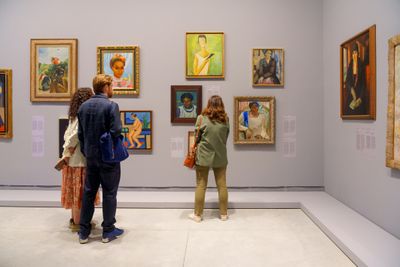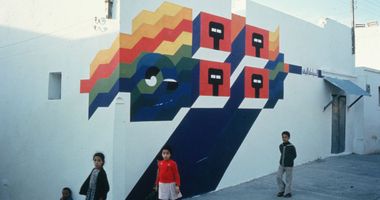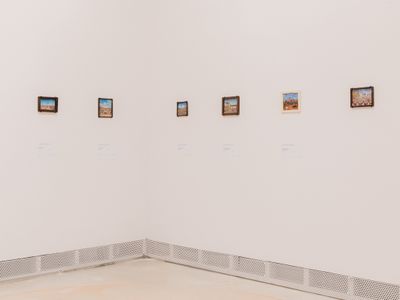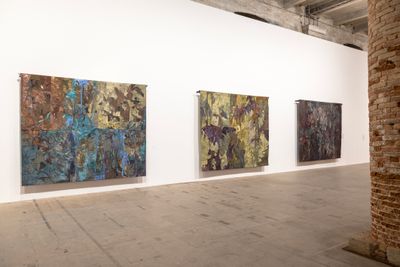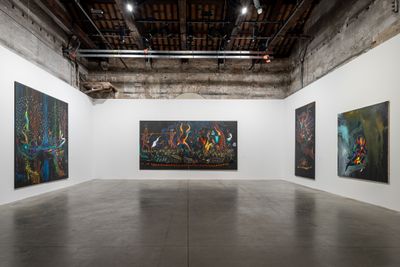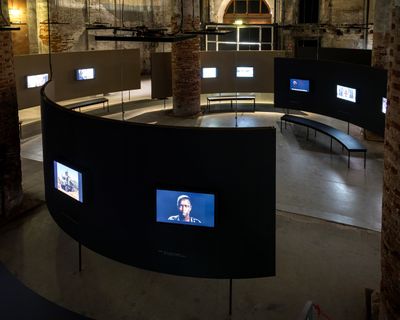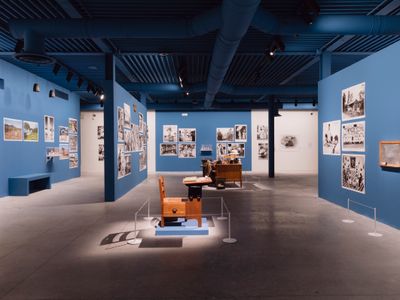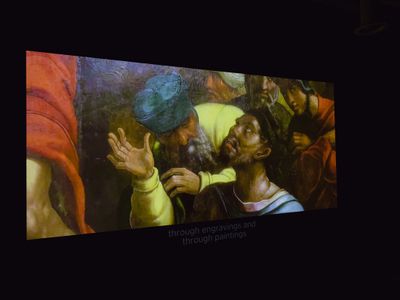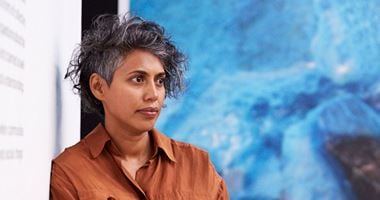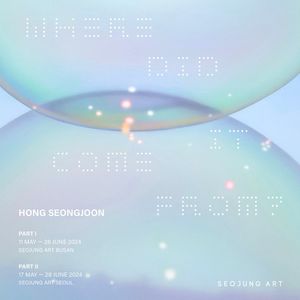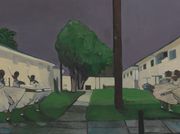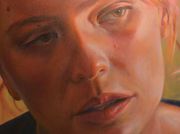The Venice Biennale’s Bare Minimum: Reviewing the Central Exhibition
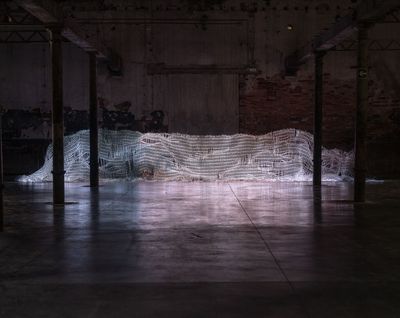
WangShui, Lipid Muse (2024). Live multichannel simulation. Exhibition view: Stranieri Ovunque – Foreigners Everywhere, 60th International Art Exhibition – La Biennale di Venezia (20 April–24 November 2024). Courtesy La Biennale di Venezia. Photo: Andrea Avezzù.
When it comes to assessing the capacity of the Venice Biennale's central exhibition to reflect the current state of global modern and contemporary art, the bar is arguably set quite low.
Only in 2015 did the world's oldest art biennale see its first African-born artistic director, Okwui Enwezor, stage a galvanising reimagination of global futures, while just five women—all European—have held the title since 1895, with Cecilia Alemani mounting an overdue women-focused curatorial in 2022.
Billed as the first edition led by an openly queer curator, Adriano Pedrosa, who is also the first Latin American artistic director, Stranieri Ovunque – Foreigners Everywhere (20 April–24 November 2024) raises the bar a little higher.
Pedrosa describes the central show as paying 'a historical debt'. Part of this payment is exacted through the Nucleo Storico section, with three rooms in the Giardini's Central Pavilion filled with salon-style hangings of 20th-century paintings by artists from Africa, Asia, the Middle East, and Latin America, most of whom are showing in the Biennale for the first time.
A central room focuses on abstract paintings by 37 artists, including an untitled 1978 acrylic on canvas vision of sand waves blending in and out of a turquoise surface by Tomie Ohtake, who migrated to Brazil from Japan in 1936; and Filipino modernist Nena Saguil's oil on canvas Untitled (Abstract) (1972), containing spiralling layers of mauve, blue, red, and greyscale circles.
Many have critiqued this space for its curatorial flattening, defined by surface-level similarities like comparable shapes. In the cases of Casablanca Art School founding member Mohammed Chebaa (Composition, 1974), Iranian modernist Mohammad Ehsaei (Untitled, 1974), and Iraqi painter Rafa al-Nasiri (Untitled, 1971), brightly coloured linear and cursive striped patterns draw from Arabic and Persian scripts.
In another section focused on portraiture, paintings cramming the walls are again organised according to aesthetic connections and subjects. My Family (1968), a glowing oil on canvas composition by Indonesian painter Hendra Gunawan, is hung alongside paintings like Gazbia Sirry's oil on canvas Portrait of a Nubian Family (1962).
The Nucleo Storico's clustering of single works by some of global modernism's most significant figures—including self-portraits by Georgette Chen, Ahmed Morsi, Anita Magsaysay-Ho, and Saloua Raouda Choucair—raises issues elsewhere.
Positioned in the corner of one room dedicated almost entirely to paintings of queer male bodies and interiors by young American painter Louis Fratino, is Fishermen in Goa (1985), a luminous oil on canvas composition of three men sitting by the sea tending to their daily catch, by Bhupen Khakhar, widely remembered as India's first openly gay artist.
The ratio is unnerving. While certainly beautiful, the volume of Fratino's paintings seems to sideline Khakhar's groundbreaking queer modernism as a historical footnote intended to elevate Fratino instead.
Still, as curator Hammad Nasar noted during the forum 'A World of Many Worlds', a collateral event organised by Asia Forum with the Asymmetry Art and Bagri foundations, seeing the work of an artist like Anwar Jalal Shemza in the central show, showing circles and semi-circles arranged on a grid in Composition in Red, Green, and Yellow (1963), means something. Especially to those who have been working for decades to expand the landscape of art history beyond an old-world Western canon.
But that's where much disappointment stems. So many have indeed done and are doing the work, yet the Venice Biennale can barely keep up with the world it purports to represent, which results in the slow-clap historical revisionism that has defined its central show for this edition and the last.
Far from evidencing a culture of looking backwards, however, there is a forward thrust to these redresses. Take the historic presence of Indigenous artists in the Nucleo Contemporaneo portion of Foreigners Everywhere, which includes paintings by Maya Kaqchikel artist Rosa Elena Curruchich that document her community.
Highlighting differences in form and function, Curruchich's compositions, painted in miniature to hide and transport during Guatemala's Civil War, were not made to be valued aesthetically within the context of the modernism-to-global-contemporary-art industrial pipeline. Rather, these are narrative paintings intended to preserve and transmit the stories of Curruchich's people—and to have them told in a historic heart of empire means something, too.
But while Foreigners Everywhere challenges audiences to resist reducing art-as-culture to aesthetics, it doesn't quite manage to clear that jump since Nucleo Storico seems to do just that.
Nevertheless, Pedrosa mounts a more convincing challenge at the Arsenale, which opens with Mataaho Collective's Golden Lion-winning installation Takapau (2022). The Corderie columns have become a frame for a magnificent architectural weave of reflective silver straps forming a triangular arch over the space.
Walking through the Arsenale, the memory of Takapau draws attention to the building's fish-boned wooden ceiling, reframing the space as a site of gathering where stories are shared.
Dalton Paula's 'Full-Body Portraits' series (2024) shows historical figures from anti-slavery resistance movements in Brazil, including Tereza de Benguela, who led an escape of Black and Indigenous people and founded the Quariterê quilombo in the 18th century.
Each portrait is painted over an olive-green ground with outlines rendered, batik-like, in unpainted primed white canvas, recalling Sangódáre Ghádégesin Ajalá's astounding batik paintings of Yoruba rituals, festivals, and quotidian scenes created during his lifetime (1948–2021), nearby.
Claudia Alarcón's geometric textile knits created with Silät, a collective of artists from the Wichí community of northern Argentina, honour stories passed down from community elders about the relations between living things. While Nour Jaouda's fabric collages of vegetal-dyed cloth pieces sewn together to create voluminous tapestries based on her grandmother's fig trees in Libya, refer to Palestinian poet Mahmoud Darwish's writings on the souls of olive trees.
River Claure's photographic installation Warawar Wawa [Son of the Stars] restages Antoine de Saint-Exupéry's 20th-century tale Le Petit Prince, of a boy who travels the cosmos, in the context of the Andes.
Located between Indigenous and contemporary space-time, Claure's images are incisively playful and sharply composed. In one shot, a boy is photographed between two women with wavy, wired braids, as other braids enter the frame from all sides.
Connecting these artists is an understanding of art as an expression of living culture that evolves through transmission. Pedrosa anchors that idea across Foreigners Everywhere with pairings of works by Indigenous family members, including Santiago Yahuarcani and his son Rember Yahuarcani, of the Aimeni (White Heron) clan of the Uitoto Nation of northern Amazonia.
Santiago Yahuarcani's pigment and acrylic paintings on unstretched llanchama cloth depict Uitoto myths and histories in earthen tones and dense patterning. Among them is Shiminbro, el Hacedor del Sonido (2023), which highlights Uitoto relationships with the rubber tree before the Peruvian Amazon Company enacted the Putumayo genocide between 1879 and 1912 to extract rubber from the Amazon.
Rember Yahuarcani's acrylic paintings likewise tap into the animistic worldview of the Uitoto Nation, with glowing, wisp-like strokes of turquoise, emerald, vermilion, and violet depicting entanglements of Amazonian animals, plants, spirits, and people on black canvas.
Embodying the artist's view that 'myths are in constant motion', Rember Yahuarcani's earthly futurism resonates with Joshua Serafin's video installation VOID (2022–ongoing), showing a mud-coated figure emerging from the ground, as much as WangShui's interwoven LED mesh sculpture, Lipid Muse (2024), composed of pulsing lights based on programmed neural networks, which concludes the Arsenale show.
Yahuarcani has discussed his practice in relation to an ancestral avantgarde, calling out the contemporary art world's inability to open up to the condition where, as his father once told him, the story is the most important part of the work.
'What my work seeks, beyond hanging my work in a gallery or museum,' he said in a 2021 interview, 'is horizontality, respect and recovering that dignity that has been taken from us in the last hundred years.'
That recovery includes engaging with traditions of representation that draw on other lineages, without reducing them into the historical framework of modern and contemporary art, whose internationalism is rooted in Western modernity.
Which is to say: it's not enough to say you're a secular atheist (read: enlightened), as one critic did, to abscond from engaging with forms of art-making where myths function as conceptual and relational forms and structures that both defy and respond to the histories of domination that have shaped the international world order, including the contemporary art world.
Just look at the Venice Biennale's professional preview, an industry event when the Biennale's origin as an imperialist art fair is at its most transparent, with advisors, collectors, curators, and PR agents joining galleries promoting their artists in the main programme, or those with exhibitions in the city.
The Venice Biennale, in fact, is where the concept of the 'global art world' breaks down. There are those who take water taxis, those who walk to avoid paying for the vaporetto, and those who cannot visit at all. In this art world, we are not the same.
That palpable difference is amplified in the Arsenale by Marco Scotini's evolving multiphase project, Disobedience Archive (2005–ongoing), comprising videos documenting activist movements across geographies and decades.
Among them is Daniela Ortiz's puppet show, The Brightness of Greedy Europe (2022), where the image of a Palestinian flag that reads, 'BOYCOTT ISRAELI PAVILION FREE PALESTINE!', has been burned into the video, drawing attention to Biennale-focused protests that took place before and during the preview around the Israeli Occupation Army's ongoing military assault on Gaza.
There is a politics of Western complicity here that a few powerful works in Foreigners Everywhere highlight, pointing to the violent contradictions historically baked into the notion of an international community that keeps exhibitions like this—not to mention international institutions more broadly—in a gruesome, ouroboric loop, if not death spiral.
At the Giardini's Central Pavilion, Pablo Delano's ongoing installation The Museum of the Old Colony confronts the oppression of the Puerto Rican people by the U.S. state. Archival images, footage, and objects touch on the classification of Puerto Rico as an 'unincorporated U.S. territory', the treatment of the island as an American playground, and racist, colonialist initiatives to 'educate' the population.
One news reel depicts the arrest of Puerto Rican nationalists Lolita Lebrón, Rafael Cancel Miranda, Irving Flores Rodríguez, and Andrés Figueroa Cordero, who entered the visitors' gallery in the United States Capitol's House of Representatives chamber in 1954 and opened fire, injuring five. On a wall nearby, Delano has placed the face of Lebrón next to that of the Statue of Liberty.
Elsewhere, Alessandra Ferrini's masterful video installation, Gaddafi in Rome: Anatomy of a Friendship (2024), explores the treachery of the Italian state in relation to its former colony, Libya, through Silvio Berlusconi's two-faced courting of Libyan leader Muammar Gaddafi in 2008, and the insidious history of bilateral agreements between both countries that reinforce the boundaries of fortress Europe.
Nearby, documentarian Fred Kuwornu's film, We Were here: The Untold History of Black Africans in Renaissance Europe (2024), highlights the erasures of history that feed nationalist politics today by recovering the presence of Black Africans in Renaissance Europe. Figures include Afro-Hispanic painter Juan de Pareja, whom Diego Velázquez enslaved for over two decades, apparently making Pareja walk the street holding the portrait Velázquez made of him to promote his talents.
Mentioned among these stories is Isabella d'Este, a patron of the Italian Renaissance. Known to send letters to her agent in Venice requesting the acquisition of a Black child, Isabella embodies the Venice Biennale's historical roots in a class- and race-based culture of objectification and proprietorship that it has yet to work itself out from—that is, if it even wants to.
Still, as Kuwornu pointed out when we spoke in Dread Scott's All African People's Consulate at Castello Gallery, this year's Biennale reflects a shift in representation worth recognising.
Besides, so long as the 'global art world' insists on making the Venice Biennale a central meeting point, the bare minimum will always feel like something. Especially when the central show is by far not the worst exhibition in Venice this year, with the abundance of monumental, church-core installations reeking of hubris staged by blue-chip artists and their investors.
On that note, while this is a central show review, shout out to Wilfredo Prieto's Curtain for the Cuban Pavilion—a stunning reminder of sense and experience beyond the gilded spectacle.
In the pitch-black hall of Teatro Fondamenta Nuove on the backstreets of Cannaregio, Prieto has restaged his 2014 work, An illuminated rock, an unilluminated rock, placing one rock under a spotlight and another left unlit so audiences seek it out in the dark. The result is a sensory engagement with both space and context, as the sounds of the city and its waters seep into the room.
That activation of site is likewise enacted at Ocean Space, where Taloi Havini has curated Re-stor(y)ing Oceania, with two stunning installations by Latai Taumoepeau and Elisapeta Hinemoa Heta that confront the real world implications of the climate emergency and rising sea levels.
There, Taumoepeau has installed eight paddle machines that emit the traditional Tongan ceremonial song of meʻetuʻupaki when activated, in an action connecting the sea peoples of Venice and the Pacific Islands, while calling allies in. Because something else the Venice Biennale tends to sideline is the lagoon and its community. —[O]
